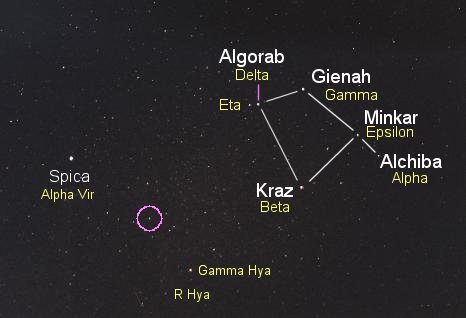 61 Virginis has a remarkable three-planet system with a "super-
earth" and two others similar in projected mass to Uranus or
Neptune.
61 Virginis has a remarkable three-planet system with a "super-
earth" and two others similar in projected mass to Uranus or
Neptune.
THE PLANETS
The circle shows the location of the sunlike class G6 star 61
Virginis (in the constellation Virgo) to
the east of Corvus. Three planet are
now known to orbit, at respective distances of 0.05, 0.22, and 0.48
Astronomical Units, with periods of 4.21, 38, and 123 days and
masses of at least 5.1, 18.2, and 22.9 times that of the Earth.
Note the especially small mass of the innermost planet. Orbital
eccentricities are fairly low for the inner two at 12 and 14
percent, though that of the outer one is more than twice as great,
which carries it between 0.94 and 0.31 AU from the star.
Unfortunately, the planets do not transit the star, so the orbital
tilts, and thus the actual masses, are not known.
|
 61 Virginis has a remarkable three-planet system with a "super-
earth" and two others similar in projected mass to Uranus or
Neptune.
61 Virginis has a remarkable three-planet system with a "super-
earth" and two others similar in projected mass to Uranus or
Neptune.
 61 Virginis has a remarkable three-planet system with a "super-
earth" and two others similar in projected mass to Uranus or
Neptune.
61 Virginis has a remarkable three-planet system with a "super-
earth" and two others similar in projected mass to Uranus or
Neptune.